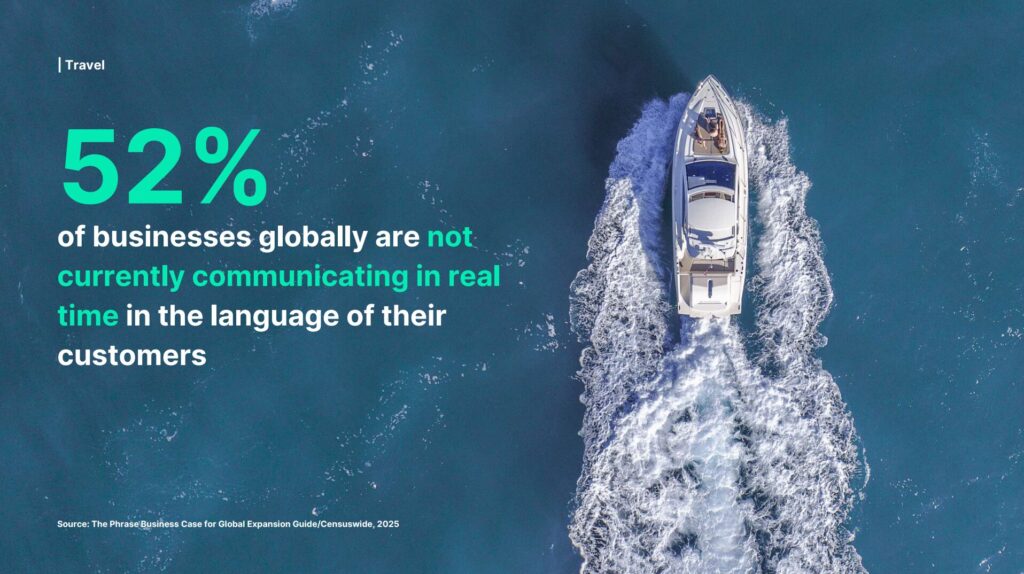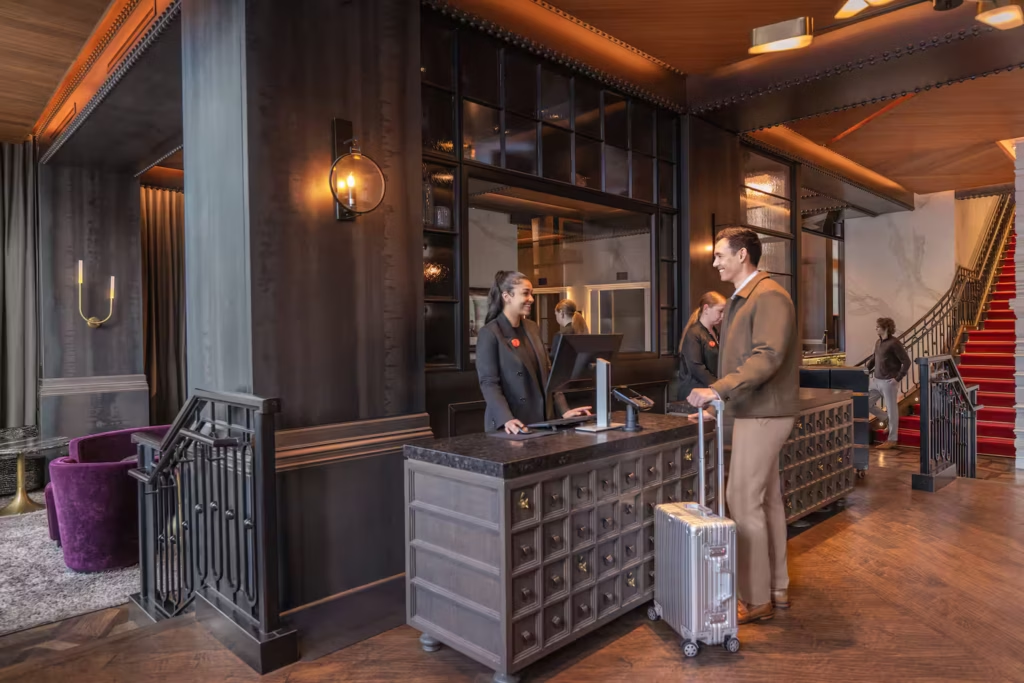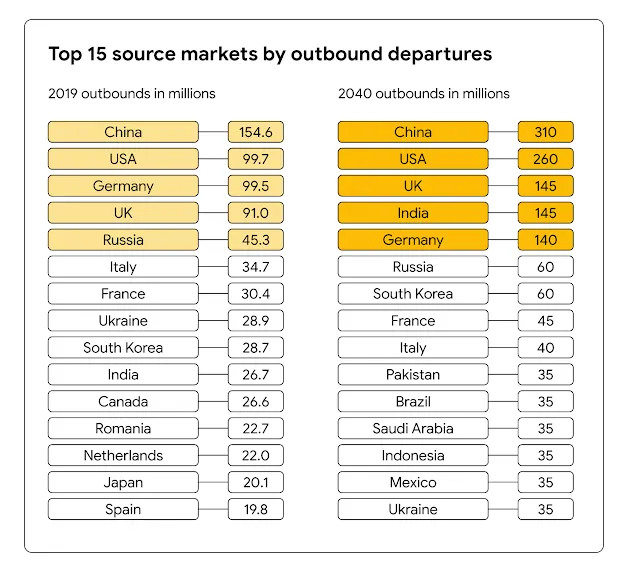Back in 2017, when the travel industry was in the midst of growth fuelled by digital transformation, then-Expedia CEO Mark Okerstrom said “being locally relevant is the recipe for success and global expansion”. As the industry has returned to growth post-Covid and artificial intelligence is spurring another round of global innovation, this sentiment continues to ring true.
Whether it’s managing inventory, handling payments, or speaking like a local, there’s a lot for a travel brand to get right when it is catering both for business travelers and tourists.
Furthermore, in tandem with the continuing digital transformation of the travel industry, customers themselves are becoming better connected and better researched than ever. They want the reassurance offered by a great brand (most often via mobile and web products), yet are still in search of something new or surprising, the type of travel they’ve seen promoted by influencers.
To put it another way, this is the balance between global reach and local resonance – the scalability paradox.
Travelers expect a bare minimum of consistency and efficiency from global travel companies – but what we’re really excited by is something that feels truly authentic (see the rise of slow, experiential or experience-based travel, as highlighted in the last 12-18 months by the likes of McKinsey and Skift, National Geographic, and ad agencies such as Dentsu).
The scalability paradox in global travel
The challenge is not just scaling, but doing so while being attuned to cultural and experiential expectations. Seamless doesn’t just mean easy, it means relevant too.
In this article, we’ll look at how technology can be used to strike a balance between global and local. We’ll also examine how important it is to tackle this scalability paradox if you’re a travel business aiming to increase your share of a market that could see 60% more international travellers by 2040, according to research conducted in 2024 by Google and Deloitte.
The Challenge: What makes for global reach and local resonance?
What do customers expect from their experiences with a global travel company? There are several core trends across product, experience and communication that tell the story of the importance of localization. Here are three of them:
Mobile experiences that work for everyone, everywhere
Mobile may dominate how travelers plan and book trips, but many travel brands still approach it with a one-size-fits-all mindset. Language support and responsive design are considered table stakes. But in practice, travelers encounter frictions that don’t show up in testing: unexpected card rejections, confusing address fields, default date formats that don’t make sense in their country, or loyalty programs that don’t recognize regional partners.
In emerging markets, mobile usage often means older Android phones, variable network speeds, and a preference for superapp ecosystems over standalone apps. These factors radically change what “good” mobile UX looks like.
Even in mature markets, expectations are shifting. Features like dynamic layouts and predictive search are raising the bar for what “personalized” means on mobile. A generic experience may no longer be enough to convert.
Yes, following WCAG standards ensures compliance, but accessible design also improves usability for all travelers. Inconsistencies across mobile platforms, devices, and bandwidth environments add further complexity. A product that works well in one region may underperform in another without deliberate adaptation.
Optimizing mobile for global travel doesn’t just mean shrinking a website into an app. It means understanding how mobile lives differently in each market and designing for those specific realities.
When travel brands take mobile seriously—not just as a functional requirement, but as a culturally and contextually relevant experience—they unlock far more than usability gains.
This kind of product localization builds brand credibility, because users feel understood and accommodated in ways that go beyond language. It also sharpens go-to-market strategy, since building localized experiences requires deep user research and insight into how different regions engage with mobile products.
Once that framework is in place, businesses can move faster; shipping localized experiences at scale, reducing time to market, and responding to market needs with greater agility. Ultimately, that creates room for sustainable growth, from increased conversion and retention to greater share of high-potential markets.
Taking off with Phrase Orchestrator: How a global travel business doubled multilingual content in just 3 nonths
Localized communication and benefits
Both brand credibility and purchase conversion are incumbent upon precise and compelling language. This makes localized communication vital, whether it’s face-to-face, in customer service over the phone, or across digital products such as apps and websites.
At its most basic, this means customers expect to book travel in their native language. In fact, across all industries, 9 out of 10 internet users will ignore a product if it’s not in their native language, according to a study by localization research firm, Nimdzi Insights.
The backdrop to this trend is that more and more people are effectively using their smartphone as a pocket translator when they travel, thanks to recent improvements in AI – either translating a website in their web browser or using an app like Google Translate for offline interactions. As this tech is democratized, customer expectations are raised elsewhere.
Machine translation and browser plugins offer surface-level solutions. They don’t address how people actually read, interpret, or engage with digital content.
Poor phrasing, mistranslated idioms, or unfamiliar sentence structures can damage a brand’s credibility. Visual elements like color, layout, or image choices often go untouched, even when they carry specific cultural meanings or influence behavior. SEO suffers when translated keywords don’t align with local search habits.
For travel companies, these issues affect core metrics. Confusion during booking, uncertainty around pricing, or unclear support options can cause users to drop off. A website that functions well technically but feels untrustworthy or misaligned with local norms will underperform, especially in markets where brand familiarity is low.
Localization addresses more than language. It includes adjusting product benefits and support channels to reflect the preferences of each region. In some markets, messaging apps like WeChat or WhatsApp are expected for customer service. In others, loyalty programs influence booking behavior far more than price. These are not edge cases. They are central to customer satisfaction and retention.
Without full localization, travel products fall short of relevance. That translates to missed revenue, lower lifetime value, and weaker market share.

Regionally tailored experiences
Though a trusted brand with familiar livery and product catalogue is no doubt enticing for the global traveler, authenticity in each market and locale comes from having a regionally relevant offering – from food and entertainment to working closer with local tourism boards.
This search for authenticity is not new; the Kimpton hotel brand, for example, was founded in San Francisco in 1981 as the first boutique hotel, “a place one could stay that felt more like a beautiful, livable and stylish home than a big, impersonal hotel” through the use of regional food and drink and, as it expanded, by adapting historic buildings.
Authenticity is at the heart of modern-day travel trends, with customers seeking experiences outside of the traditional ‘tourist trap’ and many local communities questioning or protesting over-tourism.
Skift found that three out of five US travelers believe a trip is wasted without experiencing the local culture. The travel industry news website recognized this trend in its November 2024 report, How Authentic Experiences Shape the New Tourist Economy, which implores operators and tourism businesses to “foster a sense of authenticity, immersion, participation, temporary locality, and cultural insight” if they are to stay ahead of competition.
Moving beyond the one-size-fits-all model
Too often, scaling and localization are viewed as trade-offs. But when executed thoughtfully, personalization and localization don’t slow down growth, they power it. Global travel brands that treat every customer the same may achieve consistency, but they risk becoming irrelevant.
Instead, scalable success lies in making each customer feel uniquely seen. That means using data to personalize experiences at the individual level, while also tailoring products, services, and communications to local expectations. Localization is about shaping an experience that fits seamlessly into the cultural, legal, and emotional context of each market.
Brands that embed both personalization and localization into their omnichannel strategies can unlock growth without compromise. Those that don’t risk alienating users, underperforming in new markets, and losing out to competitors who understand the value of regional nuance.
So, what does this look like in practice? Let’s examine two companies navigating one of the world’s most complex, opportunity-rich markets — India.
Case studies: Building regional relevance in mature markets
Hilton: Personalizing for SMB travelers

Hospitality giant Hilton has taken a more segmented approach to scaling its relevance across the US by launching Hilton for Business, a tailored travel program designed specifically for small and medium-sized businesses (SMBs).
Recognizing that business travelers from SMBs have different needs than enterprise clients or casual tourists, Hilton built a self-service booking and management portal for this segment. The platform offers customized benefits like 7,500 Hilton Honors bonus points for first-time users, exclusive small business rates, and simplified travel management tools.
What sets Hilton’s approach apart is the focus on audience-based localization. Rather than adjusting to different countries or languages, Hilton localized by business type, understanding that smaller teams want the perks of loyalty and ease-of-use without the complexity of corporate travel systems. This strategy aligns with the same principle that underpins geographic localization: the more relevant and streamlined the experience, the more likely users are to engage and convert.
Hilton’s SMB-focused personalization enhances brand credibility and loyalty, not just by recognizing customer needs but by designing workflows and rewards specifically for them, underscoring how localization isn’t always about geography, but about knowing your customer context.
Culture Trip: Local voices at global scale
UK-based travel platform Culture Trip offers a compelling example of how cultural authenticity and local insight can drive international relevance without sacrificing scale.
Rather than functioning purely as a booking engine, Culture Trip built its business on hyper-local storytelling. Every destination guide, article, and itinerary on the platform is authored or curated by people with regional expertise: writers, photographers, filmmakers, and creatives with direct experience of the places they cover.
This localized content strategy allows Culture Trip to deliver what many larger platforms struggle to: a genuine sense of place. Whether someone is planning a trip to Sicily or Seoul, the recommendations they see—what to eat, where to stay, which neighborhoods to explore—reflect lived experiences, not generic tourist templates.
By scaling this approach across dozens of markets and content types, Culture Trip has shown that personalization can be built into the product at the narrative level. It’s not just about adapting booking flows or payment methods; it’s about ensuring that users feel seen and inspired by voices that reflect the uniqueness of each locale.
For growing travel brands, the takeaway is clear: localization doesn’t always start with translation or technology. Sometimes, it starts with people. Brands that embed cultural insight into the foundation of their user experience can earn trust and engagement far more effectively than those who treat content as a one-size-fits-all asset.
Tackling localization in emerging markets
The aforementioned research from Google and Deloitte, ‘NextGen travelers and destinations’, highlights the rise of India as a top source market. By 2040, the country is estimated to be in the top 5 (with 145 million outbound departures), and one of the fastest growing markets.

With Indian travelers set to increase by 500% over this timeframe, there are many travel brands, both domestic and international, that are looking to cater for this demand. The market has several localization challenges, including 31 individual languages with more than 1 million native speakers at the time of the 2011 census.
Agoda
Speaking at the Skift India Summit in 2024, Agoda CEO Omri Morgenshtern spoke about how the online travel agent (OTA) approaches growth in the Indian market.
“Fundamentally, we believe tech, innovation and the speed of market is key if you want to be successful… (The) second one is heavy localization, so what we do is we try to bridge the gap for the people on the ground from everywhere else… and try to sell, say a hotel in Japan to an Indian customer [just] as if they [were booking] a hotel in Delhi, or vice versa…”
“…Our point of view is if you want to cater for the Indian traveler that goes outbound you [have] got to localize because… it doesn’t matter where they go… they want to pay with the payment options that they’re used to… they want the content to be delivered the way they’re used to, they want customer support to behave the way they’re used to.”
Omri Morgenshtern – CEO, Agoda
“So, you’ve got to localize anyhow, outbound or domestic,” added Morgenshtern.
The OTA CEO elaborated on customer support in the Indian market, detailing an average of “30% more calls per booking in India than anywhere else” and a 30% higher average call handling time.
Morgenshtern also talked about overbooking behaviour from certain partners in the country. Whereas Agoda optimizes its bookings worldwide to ensure that the numbers of people who turn up to a hotel with a booking and find there are no rooms left is kept “very, very low”, this is more commonplace in the Indian market. Tackling this phenomenon requires localized support, with Morgenshtern saying they will bring support to India “just to cater to those types of behaviours”.
The chief exec also talked about marketing localization, specifically using AI to tailor advertising messages to a country or city. Morgenshtern highlighted creative that used generative AI to “alter the lips of [Indian actor and singer] Ayushmann” creating a different version of the same ad, mentioning different things to do in that particular city. These were generated at scale and show how “tech and localization can work together”.
What brands must do: Key strategies for scaling and remaining locally relevant
So, to summarise, let’s list out three of key strategies that travel brands should be pursuing to power global expansion without compromising local relevance.
Adapting content to cultural norms
Localization begins with translation but includes everything from region-specific amenities to tailored customer support.
Any company developing a framework or strategy (see Phrase’s collection of best practices) needs to consider localization at various levels – software, website, product and marketing. Product localization alone includes initiatives such as adapting onboarding flows, localizing product tours and video, using culturally relevant images across a UI, adapting pricing models for local preferences, accounting for different devices and operating systems, adding region-specific testimonials and case studies, tailoring recommendations to local usage, as well as updating legal policies and support.
Localization technology such as a translation management system (TMS) allows travel businesses to create automated workflows that help to manage these steps. TMS platforms include machine translation capabilities for a first pass before handing off for linguist review.
Keeping development and localization in sync is key and the right platform can help to align all the relevant teams including localization managers, product managers, localization engineers, project managers, translators, reviewers, designers and testers.
Understanding the value of personalization in achieving relevance at scale
The definition of personalization is sometimes hazy, but at its heart it is simply expanding the principles of marketing segmentation. We’ve already heard how MakeMyTrip can use simple segmentation to make content more relevant for different types of customer.
And we know across industries that product recommendations based on a range of first-party data can be effective e.g. in driving discount sales or in pushing higher-end products to loyal spenders.
But with the advent of increasingly powerful and accessible models for both analysis of unstructured data and the creation of content, AI brings the prospect of some level of real-time personalization and localization of content. Think Agoda’s dynamic TV advert scaled up across communications such as email, web and mobile, to a point where comms can be automated and increasingly effective.
And with travel brands making mobile products or wearable tech (in the case of cruises or theme parks) a central part of the travel experience, the volume of first party data available becomes a key asset.
Put data insights to work in predicting local preferences
Spotting trends is one of the core strengths of AI, with models able to determine when demand is shifting. We can see this at a company like Airbnb, which uses an algorithm to set rent prices for its hosts by analysing various characteristics of the property. Airbnb’s dynamic pricing is so effective that it has even been touted as an indicator of gentrification, with pricings rising in up-and-coming neighbourhoods.
This sort of forecasting methodology can be used to help travel businesses determine not just pricing but the types of content and products certain travelers might want to buy in different markets.
The takeaway: Localization is a growth multiplier
Without hammering home the point, localization is the other side of the digital transformation coin. Even a disruptively great product needs to fit the market it’s in.
Tech now plays a huge role in allowing travel brands to localize and personalize their efforts. And with travelers taking their lead from Instagram and TikTok and wanting a unique experience designed just for them, localization has become table stakes.
Brands that serve growing markets by creating seamless products and authentic experiences will lead the next phase of travel industry growth.
Create unforgettable experiences, everywhere
Start your journey towards efficient localization at global scale with Phrase.






